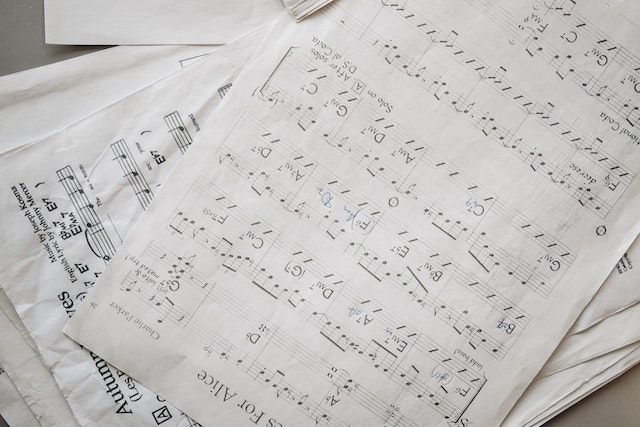How to come up with melodies: best tips and recommendations
A wonderful melody is one thing that every popular song has in common. One of the finest musical abilities one may have is the ability to compose memorable melodies over chord progressions, since a powerful melody can easily make or ruin a tune.
However, learning the craft of melody creation might be difficult, especially if you've never written a song before. We'll walk you through each stage of the melody writing process so you can create your own song quickly. Let's get started!
What is a melody?
A melody is a series of musical notes that are heard as a single unit by the listener. A melody is a combination of pitch and rhythm in the strictest sense.
Melodies frequently consist of one or more melodic phrases or motifs that are repeated in various ways throughout a work. Additionally, melodies can be classified according to their melodic motion, pitch range, tension and release, continuity and coherence, rhythm, and form.
Writing melodies may be done in a variety of wonderful ways, and melodic ideas might include many skips, simple steps, long notes, short notes, or everything in between. When seen in the context of the entire song, good melodies are simple to recall.

Types of melodies
Monotone melodies
Technically speaking, monotonous rhythmic patterns can also be melodies. This category includes certain hip-hop vocal melodies as well as some EDM dance tracks.
This doesn't imply that every drumbeat counts as a song's melody, but rather that a rhythmic pattern might act as the melody for a certain part of a song if no pitched noises are added to it.
Melodies based on chords
Some songwriters begin by composing a sequence of chord changes before beginning to construct a melody. The notes that make up each chord, or chord tones, are then used as the basis for melodies.

Melodies based on scales
Scale-based melodies are made up of notes that fall within a specific scale or mode. A C major melody, for instance, may solely make use of the notes of the C major scale.
Although major and minor scales typically include seven notes (some minor scales have more), you may still create a beautiful melody with fewer notes. The five-note pentatonic scale is commonly used in pop music composition.
What makes a good melody?
While there are many different types of outstanding melodies, there are a few key ideas to keep in mind as you develop your melody composing abilities. Here are some characteristics that excellent tunes share.
Is easy to remember
Sometimes the finest tunes are the easiest for everyone to remember because they are straightforward. Better melodies purposely repeat words to make them more memorable and catchy. You should be able to carry a nice melody around with you.

It follows a specific path
Similar to songs, most melodies have a distinct start, climax, and conclusion. A melody is made up of lyrical or melodic phrases that move across a scale and carry energy through note changes. Excellent melodies have a distinct form and focal point that aid in delivering their message.
It works in a scale
You'll want your preferred music to be in the scale you're using the majority of the time. The strongest three or four notes in a given scale are frequently highlighted in great tunes.
What makes a bad melody?
It doesn’t focus on a scale
You shouldn't merely pick notes at random while creating a melody. For lyrical effect or during a chord change, it may be appropriate to deviate from your standard scale, but most of the time, maintaining your melody in the same key makes it much simpler for a melodic line to fit in with the rest of a song.
It doesn’t have a structure
Strong melodies may smoothly transition from the lowest note to the highest tone, creating movement and carrying energy. A brief musical notion with shape, contrast, and the primary idea of the piece is carried by a powerful melody.
How to male a melody for a song
Choose a scale
Finding a scale to start with can help you to develop a melody that will stick. If you haven't decided on the tone of the musical soundtrack, this might be based on a chord sequence or you could start with a scale.

Generally speaking, a major scale-based tune will sound happier than a minor scale-based melody. If you're unsure of where to begin, try working in the straightforward key of C major.
All of the natural notes, or C D E F G A B, make up the c major scale. You might use the C D E G A major pentatonic scale to make it more simpler.
Construct upon a chord progression
After choosing the notes you want to utilize, it could be useful to create a major or minor chord sequence so you have a base from which to riff. If you don't know how to compose chords, you can look up common chord progressions online or use a background track from YouTube.
Begin with the beat and lyrics
Sometimes it's simpler to work out the rhythm and words before you start playing your tune. To test what sticks, try uttering various words over your looping chords. You could discover that one type of phrase is more effective than another.
Be creative
Learning to compose a melody requires a lot of intuitive work. Start playing or singing the notes in your pentatonic scale or another scale over the recorded backing track using your voice memos or recording device. You may even start using pre-written lyrics or a defined beat.
Start working on the verse melody first
Since the chorus melody is under so much strain, it might be simpler to focus on the melody in the verse of a song first. Once you understand the background of the verse, you might discover that producing a new melody for the chorus comes to you effortlessly.
Think about several alternatives
There are several effective ways to create a melody. Spend some time considering various melodic possibilities. Try trying several high note climaxes, making a tiny rhythmic adjustment, or even experimenting with new lyrics.

Wait a bit before finishing the melody
Consider all of your melody alternatives before settling on one. You can tell which songs didn't stick in your brain when you return by seeing which ones did.
How to come up with melodies - Conclusion
It takes work to develop into an exceptional melody writer. It will get simpler as you compose more melodies. Spend some time honing this talent and experimenting with various melody composition approaches to see what suits you the best.
If you liked this post and would want to read more tips for your music career and general information about the music industry, please visit our blog section.
You're here because you love music, so please try to listen to it together with your friends or strangers, at the same time, connected by webcam in CalypsoRoom.
In CalypsoRoom we believe music is the most powerful tool to bring people together, and for this reason, we developed an online music social network where you can connect with friends or strangers while listening to music simultaneously, connected via webcam.
Are you a music artist or label and do you want to give your music a further dimension? Do you own or co-own the master and publishing rights to your music? If yes, consider to post it on CalypsoRoom: it’s free, you keep 100% of your copyright, you promote your music in a new way, and you get a new revenue stream! Check it out.
Thanks for reading,
CalypsoRoom Team
back
Written by CalypsoRoom Editorial Team
The CalypsoRoom Editorial Team is a skilled and diverse group of writers, researchers, and industry specialists who have access to Calypso's data and information in order to give you broad knowledge about the music industry as well as helpful advice to help you manage your music and dancing career.
Updated January 2023
Company number: 681223
James's Walk 31, Dublin, Ireland
contact@calypsoroom.com
+353 (89) 435 8928





